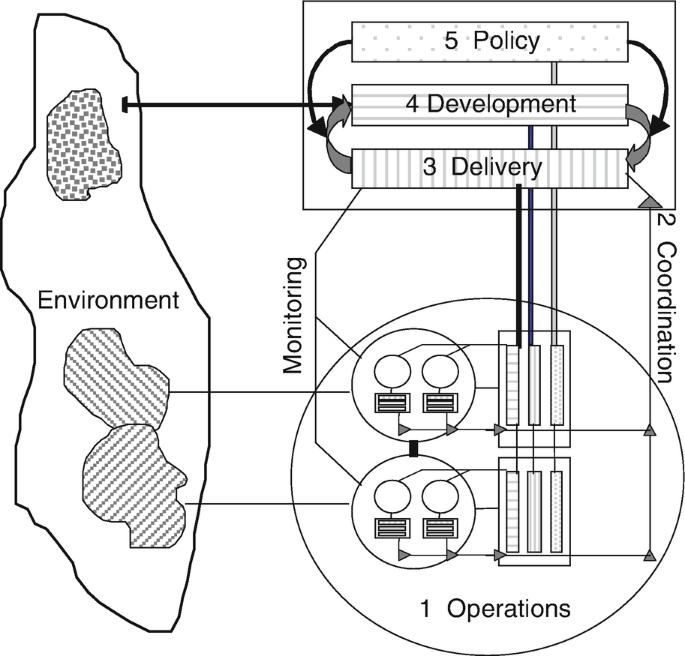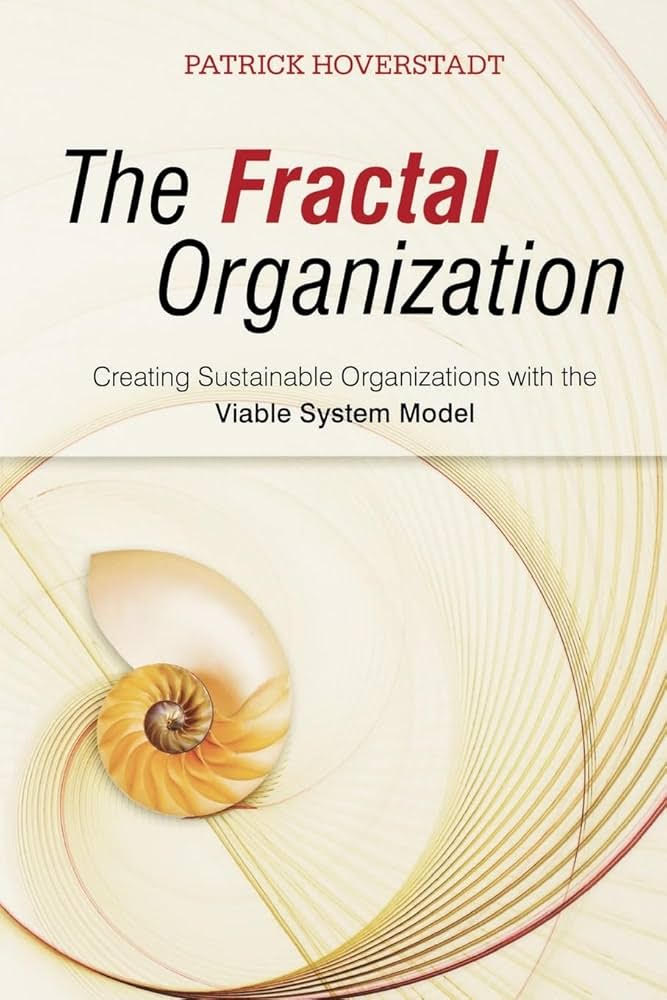Patrick Hoverstadt’s The Fractal Organization offers an insightful look into why so many organizations fail and lays out a systemic blueprint for how they can be made viable, adaptive, and sustainable. Grounded in the Viable System Model (VSM), the book argues that most organizational failures stem not from bad execution or poor intentions, but from flawed mental models, outdated structures, and a chronic mismatch between internal capabilities and external complexity.
A Crisis of Structure, Not Just Strategy
Hoverstadt begins by confronting a sobering reality: most strategic plans are never implemented, most change programs fail, and most companies don’t survive beyond a few decades. He attributes these failures to an inability to manage complexity and change—forces that are escalating and mutually reinforcing. As environments become more turbulent, organizations respond with either bureaucratic rigidity or panic-induced restructuring—neither of which addresses the root problem: their internal systems are not designed to handle variety, evolve, or coordinate effectively.
The dominant models of management, Hoverstadt argues, are relics of a more stable era. Business schools continue to teach command-and-control paradigms, assuming that linear planning, hierarchy, and compliance will suffice. But in a world shaped by rapid technological shifts, stakeholder pluralism, and global interconnectivity, these approaches collapse under pressure. The book offers the Viable System Model as a superior alternative—one that treats organizations as living systems with recursive structure, internal intelligence, and adaptive capacity.
Myths, Models, and Mental Traps
A core theme of the book is that organizations are shaped by the mental models of those who run them—and that these models often operate tacitly and unchallenged. Hoverstadt critiques common assumptions, such as the belief that “nice guys finish last” or that employees need constant oversight. These beliefs become self-fulfilling: if managers expect mistrust, they will design control-heavy systems that elicit low trust. If they believe people resist change, they will frame transformation as a top-down imposition.
He critiques reductionist thinking, especially the tendency to search for singular causes in complex systems. Organizational problems, he insists, are systemic—they arise from patterns of interaction, feedback loops, and structure, not just individual behavior. Attempts to fix them through training, incentives, or communication campaigns alone miss the point. Hoverstadt calls instead for explicit modeling: building shared, system-level understandings of how the organization functions, where it is vulnerable, and how it might change.
The Viable System Model (VSM)
The Viable System Model is Hoverstadt’s solution that lies at the heart of the book.

It identifies five interrelated systems that must be present and functioning in any viable organization:
- System 1: Operational units delivering value
- System 2: Coordination mechanisms between units
- System 3: Internal regulation and resource management
- System 4: Development, intelligence, and external sensing
- System 5: Policy, identity, and integration of purpose
Each of these systems is necessary for viability. More importantly, each viable unit within an organization—whether a team, a division, or a business unit—must itself contain all five systems. This fractal, recursive structure is what allows organizations to manage complexity at scale without reverting to over-centralization or chaos.
Hoverstadt shows how failures in each system lead to predictable dysfunctions: operational overload (System 1 failures), duplication and interference (System 2 failures), loss of cohesion (System 3), obsolescence (System 4), or identity crises (System 5).
Autonomy, Control, and Structure
Hoverstadt tackles the autonomy–control dilemma by showing that it is a false dichotomy. Organizations do not have to choose between rigid centralization and anarchic decentralization. Instead, they can structure negotiated autonomy into their systems: defining clear roles, boundaries, and feedback mechanisms that allow units to act independently while still aligning with the whole. He warns against “autonomy traps,” where units appear empowered but are structurally incapable of delivering.
This leads into a discussion of value creation. Many organizations are structured by history, politics, or habit—not by how they actually create value. Hoverstadt urges managers to analyze complexity—what comes from products, geographies, technologies, or customers—and to design structures that match it. Misaligning structure with value logic results in archetypal pathologies like silos, overlaps, and duplications.
He offers the recursive principle of the VSM as a guide: each business unit should be a viable system, capable of operating, coordinating, managing itself, adapting to change, and contributing to policy. By distributing these capacities throughout the organization, one avoids the bottlenecks and brittleness of hierarchical control.
Coordination, Cohesion, and Monitoring
Coordination (System 2) is often misunderstood as managerial interference. But in Hoverstadt’s view, it is what enables interdependent units to operate without clashing. Coordination mechanisms—formal and informal—are needed whenever units share resources, customers, or workflows. Done well, coordination reduces oscillation and builds predictability; done poorly, it becomes bureaucracy.
System 3—the performance management system—ensures the organization functions as a whole. It is not about micromanagement but about creating structural cohesion. Hoverstadt stresses the importance of clear accountability and warns against relying solely on KPIs or dashboards. Numbers devoid of context are often misleading. What’s needed is feedback, context-rich auditing, and the ability to compare reported performance with on-the-ground reality.
This leads into System 3, the internal monitoring channel. It bypasses formal reporting to verify integrity. Done sparingly and respectfully, monitoring builds trust and corrects distortions. Done poorly, it creates fear, theater, and “institutionalized deceit.” Hoverstadt shows how systems break down when performance monitoring becomes performative—when appearances trump reality.
His definition of trust—credibility multiplied by intimacy, divided by risk—is both memorable and practical. He argues that organizations lose trust when they lose integrity—not in a moral sense, but in a structural one. Fragmented messages, inconsistent behavior, and misaligned subsystems all breed mistrust.
Viability, Intelligence, and Strategic Risk
Hoverstadt redefines performance in systemic terms: it is not just about short-term delivery, but about long-term viability—the ability to survive, evolve, and self-correct. He criticizes narrow performance metrics that ignore learning, governance, and environmental fit. Good management cannot be judged by isolated outcomes; it must be understood in terms of whether the system is becoming more or less viable over time.
System 4—intelligence—is central to this. It connects the organization to its environment and future. Intelligence is not just market research or competitor analysis; it is the ability to make sense of ambiguity, challenge assumptions, and revise mental models. Hoverstadt warns against dismissing intelligence functions as speculative or peripheral. Without them, the organization becomes blind.
He presents strategic risk as the most under-managed threat in modern organizations. While compliance and operational risks are well tracked, strategic risks—those that arise from structural uncoupling with the environment—are often ignored until it is too late. Organizations that rely on inherited success, suppress dissent, or cling to outdated strategies fall into what he calls “the death spiral.”
Hoverstadt outlines how to scan for strategic risks, evaluate them, and embed feedback systems that detect weak signals. He calls for governance structures that institutionalize openness, deliberation, and rapid response—not just compliance.
Strategy, Innovation, and Change
Rather than treating strategy as a linear planning exercise, Hoverstadt defines it as an emergent, systemic conversation between the present (System 3), the future (System 4), and the organization’s identity (System 5). Strategy cannot be imposed top-down; it must be fractal, with each viable unit developing its own strategic view and aligning it through negotiation. The purpose of strategy is not to control the future, but to continuously renegotiate fit with a changing environment.
Innovation is central to this adaptive capacity. Hoverstadt rejects both the romanticism of the lone genius and the bureaucracy of “innovation by committee.” He argues for bounded autonomy: creating structural spaces where innovation can occur without being killed off—or destabilizing the main system prematurely. Innovation must be measured not just in terms of outcomes (actuality), but in terms of potentiality—the capacity it creates for future adaptation.
Change, he writes, often fails due to internal resistance and inertia: because it is treated as an overlay rather than a systemic transformation. His concept of mosaic transformation—inspired by biological change—is a model for managing organizational change in patches, in sequences, and in interaction. Change is not linear or uniform; it happens in differentiated subsystems, each with their own timing, dynamics, and readiness.
He lays out a method for change that includes modeling the current and desired states, sequencing interventions, managing boundary effects, and building up momentum through reinforcing change. He insists that change must be embedded in systemic design, not imposed as an initiative.
Identity, Purpose, and Governance
The final chapters deal with identity and governance, showing how systemic design extends to the philosophical level. Hoverstadt argues that organizations often confuse mission statements with actual purpose. In reality, an organization’s purpose is what it does—not what it says it does. And its identity is formed not only internally but through its structural coupling with the environment.
He explores how multiple, conflicting stakeholder demands give rise to multiple identities. Rather than resisting this complexity, viable systems must manage it—assigning different parts of the organization to serve different demands, and making these decisions transparent. Hoverstadt uses metaphors like boundary drawing (e.g., the myth of Romulus and Remus) to show how identity is always a function of inclusion and exclusion—what is inside the system and what is outside.
Governance, finally, is not about compliance or board meetings—it is about the organization’s ability to steer itself. Good governance preserves order amid change and change amid order. It requires feedback loops, distributed autonomy, and structural coherence. Governance, like strategy and innovation, must be recursive—designed into every layer of the organization, not reserved for the top.
Conclusion
Hoverstadt’s book is ultimately a call to think systemically. Organizations are not machines to be controlled, but are viable systems, and they succeed or fail based on how well they are structured to manage complexity, adapt to change, and coordinate internally. The Viable System Model offers a way to see the organization whole—to diagnose, design, and govern with structural intelligence. Hoverstadt writes that “The Viable System Model has been described as a ‘master organizing idea’, in other words a concept that allows other tactical tools and approaches to be placed in their proper context with one another.”
The central message is clear: viability is not an accident. It is the product of deliberate, systemic design—design that must be recursive, distributed, and continuously evolving. In a world of mounting complexity and accelerating change, only organizations that understand themselves as living, adaptive systems can survive.







